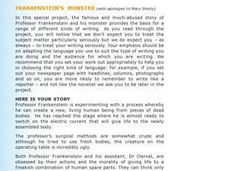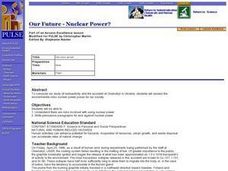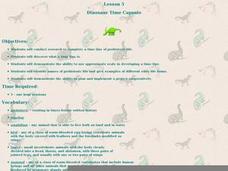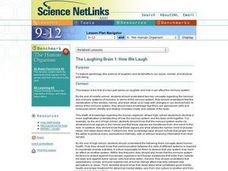Curated OER
Heart 2: Changing Lifestyles and Heart Health
Students examine and evaluate changes in diet and lifestyle from prehistoric to modern times and how these differences have spurred the development (and better treatment) of heart disease.
Curated OER
Avoiding Sports Injuries
Learners research sports injuries and how to deal with the injury. In this injury prevention instructional activity, the teacher introduces several exercise risk factors and prevention techniques, then students work in small groups to...
Curated OER
Animal Coverings
Students categorize animals by their coverings. They list descriptive words, explore a science center with actual animal coverings, match pictures of animals with coverings, and categorize pictures of animals by their coverings on a...
Curated OER
Chemical Controversy
Students explore the endocrine disruption theory. They work in groups to research and develop a persuasive oral argument to support one side of the endocrine disruption theory. Students engage in debate and other activities to analyze...
Curated OER
Jumpy Dolls
Students are challenged to design and construct a jointed figure that moves in a motion something like jumping jacks when a string is pulled.
Curated OER
Shells
Sixth graders label diagrams of the 6 different classes of mollusks and explain the meaning of the labeled terms. They identify 8 common New Haven shells. They organize their own shell collection during this series of lessons.
Curated OER
Five Senses - Learning With The Senses
Students name the five senses, compare learning with and without the senses.
Curated OER
My Beating Heart
Students watch a video over the functions of the heart. They follow along on a website to see how the heart pumps blood.
Curated OER
Turkeys Gobble Up Bulletin Board Space
Students state the reasons they are thankful. They follow directions to create feathers for a bulletin board turkey. They share their feathers before it is placed on the board.
Curated OER
Molecular Evidence for Evolutionary Relationships
Students compare the amino acid sequences in cytochrome-c for a variety of organisms and use this information to infer evolutionary relationships. Students investigate the role of homeobox genes and what this indicates about the...
Curated OER
Frankenstein's Monster
Students read Mary Shelly's Frankenstein. Using situation and question prompts, students write various essays, letters, and articles concerning the events in the story from different character's point of view.
Curated OER
Our Future - Nuclear Power?
Students comprehend that there are risks involved with using nuclear power. They write persuasive paragraphs for and against nuclear power. Students analyze the environmental issues and risks with nuclear power.
Curated OER
Homeostasis
Students explore homeostasis and identify it in work in an organism. They brainstorm things that stay the same and participate in several demonstrations that illustrate homeostasis. Students predict baseline breathing and jumping jacks
Curated OER
Beaver Ecology
Students explore the lives of bgeahvers. They identify the physical and behavioral adaptations that help beavers survive in their environment. Students compare and contrast how beavers influence the ecology of both forest and aquatic...
Curated OER
Animal Coverings
Summary: Categorize animal pictures by their coverings. Show photographs of animals. Ask students to give descriptive words as to how they think the animal's covering would feel if they could actually touch it.
Curated OER
Paper Puppet
Students create hand puppets using basic art supplies, paper cups, cotton balls, and yarn in this 1st and 2nd grade Art lesson plan. Emphasis is placed on the history of puppets and puppetry. The lesson plan includes a short vocabulary...
Curated OER
Dinosaur Time Capsule
Third graders research prehistoric life using educational software. They design a prehistoric life while showing the use of appropriate scale and names for the prehistoric life. They follow an internet link to participate in a virtual...
Curated OER
Verterbrate Classification
Students are introduced to the broad categories of vertebrates including fish, amphibians, reptiles, birds and mammals. They identify the characteristics of each group and then view slideshows and video of example species.
Curated OER
Check Out Lights and Shields with Beads
Students explore Ultraviolet detecting beads and conduct several investigations with them. In this investigative lesson students participate in an experiment to see the harmful effects of UV light and discuss their findings.
Curated OER
Inside Information
Learners explore two pathways for information through the nervous system. The pathways for involuntary action or reflex and voluntary responses are built and related to the element of choice.
Curated OER
Rosie's Walk
Students use maps and globes to locate and describe locations, directions and scale. Using the maps, they identify man made or natural features of different environments. They practice using geographical terms to describe a specific...
Curated OER
The Laughing Brain 1: How We Laugh
Students to rate themselves on a scale from 1 to 10 (10 being the happiest) as to how happy they feel and write their rating on a sheet of paper. They explore gelotology (the science of laughter) and its benefits to our social, mental,...
Curated OER
Theatre Lesson Plan, Performing a Story
Second graders read the story, The Bundle of Sticks, and discuss the story elements within the story; setting, plot, conflict resolution. For this readers theater lesson, 2nd graders reenact the story in small...
Curated OER
Fairy Tale Press
Learners create the front page of a newspaper by writing news stories about the main characters and plots of fairy tales.
Other popular searches
- Human Body Parts Pictures
- Human Body Parts
- Spanish Human Body Parts
- Human Body Parts Edible
- Human Body Parts Bingo
- Main Human Body Parts
- The Human Body Parts
- Human Body Parts Photographs
- Human Body Parts Worksheet
- Pics Human Body Parts
- Human Body Parts Names
- Human Body Parts Poster























